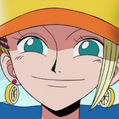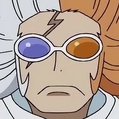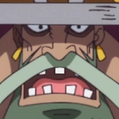GoldenOath20 (talk | contribs) (Dofamingos stings are not a special paramica, and we dont know the critera for being a special paramicia) |
No edit summary |
||
| Line 8: | Line 8: | ||
|first = [[Chapter 1]]; [[Episode 1]] {{qref|name=first|chap=1|ep=1|the concept of Paramecia Devil Fruits and Devil Fruits in general is introduced when Luffy eats the Gomu Gomu no Mi.}} |
|first = [[Chapter 1]]; [[Episode 1]] {{qref|name=first|chap=1|ep=1|the concept of Paramecia Devil Fruits and Devil Fruits in general is introduced when Luffy eats the Gomu Gomu no Mi.}} |
||
}} |
}} |
||
| + | |||
'''Paramecia''' is one of the three [[Devil Fruit]] types. |
'''Paramecia''' is one of the three [[Devil Fruit]] types. |
||
Revision as of 01:48, 1 February 2020
Paramecia is one of the three Devil Fruit types.
These fruits give the users a power that can affect their body, manipulate the environment, and/or produce substances. In general, Paramecia Devil Fruits are fruits that give their users powers other than transforming into natural elements, like Logias, or transforming into animals, like Zoans. Although they do not include powers that allow elemental or animal transformations, some of them are capable of other forms of transformations, as well as creating substances.[1]
In the edited dub (and later episodes of the uncut dub) and official subtitles, this type is called Paramythia. The term Paramecia was first used when Wyper witnessed Luffy's Devil Fruit abilities.[2]
Overview
Paramecia are the most common type of Devil Fruit. They come in a variety of forms which can be divided further into several subcategories.
With such a broad range of available powers, it is difficult to generalize the abilities offered by Paramecia fruits. However, it appears that the effects of this Devil Fruit type can be categorized into two basic groups: those which are based on a characteristic (such as elasticity or slowness) or an object (bombs, doors, etc.). Paramecia types are also distinguishable in the manner in which their powers manifest. They can either alter the user's current physical state (Luffy and Bon Kurei), directly affect their immediate environment and/or living things within proximity (Eustass Kid, Blueno or Whitebeard), or affect both of these conditions (Jewelry Bonney, Trafalgar Law and Emporio Ivankov). There are also those that share common themes and powers which make them seem like a category all their own, such as weapon transformations (Daz Bonez, Wapol and Baby 5), food production (Streusen, Charlotte Cracker and O-Tama) or the manipulation of one's own soul and those of others (Brook, Perona and Charlotte Linlin).
How to trigger the fruit’s power can also differ from user to user. For instance, the Gomu Gomu no Mi, Yomi Yomi no Mi, and Sube Sube no Mi have powers that are passively active at all times, while others such as the Noro Noro no Mi and Hana Hana no Mi require self-activation.
Some of the abilities and powers granted by Paramecia fruits may have little to no combat combative capabilities such as the Chiyu Chiyu no Mi. However they may have uses outside of combat, as the Chiyu Chiyu no Mi grants the ability to heal both individuals and objects. It should also be noted that even Paramecia fruits with combative capabilities may also have general or ingenious uses outside of combat. For example, the Hana Hana no Mi ability to bloom body parts has various applications such as spying or gathering information by blooming ears and eyes to use for eavesdropping. Another example is the elastic body granted by the Gomu Gomu no Mi, allows the user to consume large quantities of food due to their elastic stomach and digestive system, though as a result this gives the user a bigger appetite.
There are also many types of Paramecia that could be easily mistaken as Logia, either due to the user's ability to release near-limitless amounts of a particular substance (or energy) in relation to the power their fruit gives (Galdino, Kalifa, Magellan, Doflamingo, Trebol, Perospero, Cracker, and Oven), or that they are able to mimic the properties of certain existing matter (Luffy, Bonez, Jozu, and Pica). These types of Paramecia are not to be confused as Logia, though, since the users of the former category cannot convert themselves into their respective substance, nor do those particular substances count as elemental forces that defines a Logia, and neither can those from the latter sort generate the same aspect from their bodies that they are capable of transforming into. Basically, while an "elemental" Paramecia can allow the user to generate, control and be immune to their element, they can not actually become that element or regenerate, like a Logia user. Trebol took advantage of his ability and physique to cover himself in his particular substance, deceiving his opponents into believing that he is a Logia when they strike the empty cavities of the shell.[3]
The only exception to the rule above is Charlotte Katakuri, the user of the Mochi Mochi no Mi which has been called a "special Paramecia" (特殊な
Although not transforming into a substance to achieve the Logia-like intangibility, Baby 5 has shown to posses similar abilities, being able to transform her body (or parts of it) into weapons and can regenerate herself from any damage done to her while in her weapon form. Non-canonically, Artur Bacca can liquidize his body via his Dero Dero no Mi to avoid damage.
Paramecia-Type Users
- See also the associated category: Paramecia Devil Fruit Users.
- †: the character is deceased.
- ?: the character's status is unknown.
- ≠: the character is non-canon.
- ‡: the character is no longer part of this group. Hovering the symbol may give further details.
- *: other relevant information. Hovering the symbol gives further details.
Paramecia-Types
Canon
Named Fruits
- Gomu Gomu no Mi (English versions: Gum-Gum Fruit): Turns the user's body into rubber, giving them the power to stretch, bounce, and inflate; as well as make them immune to electricity and near impervious to blunt-force attacks and bullets. Eaten by Monkey D. Luffy.
- Bara Bara no Mi (English versions: Chop-Chop Fruit): Allows the user to split their body into separate pieces, which the user can manipulate and make fly through the air. It also makes them immune to slashing attacks. Eaten by Buggy.
- Sube Sube no Mi (English versions: Slip-Slip Fruit/Smooth-Smooth Fruit): Makes the user's skin extremely smooth and slippery, causing things to slide off them. Eaten by Alvida.
- Bomu Bomu no Mi (English versions: Bomb-Bomb Fruit/Boom-Boom Fruit): Allows the user to create explosions from their body, as well as give explosive properties to their bodily secretions. Also makes the user immune to explosions. Eaten by Gem.
- Kilo Kilo no Mi (English versions: Kilo-Kilo Fruit): Allows the user to increase or decrease their body weight at will. Eaten by Mikita.
- Hana Hana no Mi (English versions: Flower-Flower Fruit): Allows the user to sprout duplicates of their body parts from any nearby surface. Eaten by Nico Robin.
- Doru Doru no Mi (English versions: Wax-Wax Fruit): Allows the user to create and control candle wax. Eaten by Galdino.
- Baku Baku no Mi (English versions: Munch-Munch Fruit): Allows the user to eat anything and transform their body to match the qualities of what they've recently eaten. Eaten by Wapol.
- Mane Mane no Mi (English versions: Clone-Clone Fruit): Allows the user to transform into a physical lookalike of another person. Eaten by Kurozumi Higurashi until her death and later eaten by Bentham.
- Supa Supa no Mi (English versions: Dice-Dice Fruit): Allows the user to transform any part of their body into a blade, thus gaining slashing abilities and making their skin as hard as steel. Eaten by Daz Bonez.
- Toge Toge no Mi (English versions: Spike-Spike Fruit): Allows the user to grow spikes from their body. Eaten by Zala.
- Ori Ori no Mi (English versions: Cage-Cage Fruit/Bind-Bind Fruit): Allows the user to create iron bindings on their opponents. Eaten by Hina.
- Bane Bane no Mi (English versions: Spring-Spring Fruit/Boing-Boing Fruit): Allows the user to turn their limbs into springs. Eaten by Bellamy.
- Ito Ito no Mi (English versions: String-String Fruit): Allows the user to create and control strings. Eaten by Donquixote Doflamingo.
- Noro Noro no Mi (English versions: Slow-Slow Fruit): Allows the user to emit special photons that slow down anything they touch for 30 seconds. Eaten by Foxy.
- Doa Doa no Mi (English versions: Door-Door Fruit): Allows the user to create and open doors on anything, including walls, living beings, and the even the air itself. Eaten by Blueno.
- Awa Awa no Mi (English versions: Bubble-Bubble Fruit): Allows the user to create and control soap bubbles that can clean anything, including strength. Eaten by Kalifa.
- Beri Beri no Mi (English versions: Berry-Berry Fruit): Allows the user to split their body into many spheres. Eaten by Very Good.
- Sabi Sabi no Mi (English versions: Rust-Rust Fruit): Allows the user to rust anything they touch, including organic material. Eaten by Shu.
- Shari Shari no Mi (English versions: Wheel-Wheel Fruit): Allows the user to turn their limbs into wheels. Eaten by Sharinguru.
- Horo Horo no Mi (English versions: Hollow-Hollow Fruit): Allows the user to create and control ghosts. The ghosts cause dispare in the people they touch and are capable of self-destructing. The user can also make their own ghost leave their body. Eaten by Perona.
- Yomi Yomi no Mi (English versions: Revive-Revive Fruit): Allows the user to return to life after dying once already, as well as allow the user to make their returned soul temporarily leave their reanimated body. Eaten by Brook.
- Kage Kage no Mi (English versions: Shadow-Shadow Fruit): Allows the user to manifest and control shadows. Eaten by Gecko Moria.
- Suke Suke no Mi (English versions: Clear-Clear Fruit): Allows the user to become invisible, as well as make anything they touch invisible. Eaten by Absalom until his death and later eaten by Shiryu.
- Nikyu Nikyu no Mi (English versions: Paw-Paw Fruit): Gives the user paw pads on their hands that can repel anything they touch. Eaten by Bartholomew Kuma.
- Ope Ope no Mi (English versions: Op-Op Fruit): Allows the user to generate a sphere-like room, inside which they can manipulate anything. Eaten by Trafalgar D. Water Law.
- Shiro Shiro no Mi (English versions: Castle-Castle Fruit): Allows the user to become a living fortress equipped with cannons, as well as letting them shrink people and objects and house them inside their body. Eaten by Capone Bege.
- Wara Wara no Mi (English versions: Straw-Straw Fruit): Allows the user to create and control straw. Eaten by Basil Hawkins.
- Mero Mero no Mi (English versions: Love-Love Fruit): Allows the user to turn people that feel attraction for them into stone. Eaten by Boa Hancock.
- Doku Doku no Mi (English versions: Venom-Venom Fruit): Allows the user to create and control poison. Eaten by Magellan.
- Horu Horu no Mi (English versions: Horm-Horm Fruit): Allows the user to create special hormones and inject them into a persons body, changing their biochemistry. Eaten by Emporio Ivankov.
- Choki Choki no Mi (English versions: Snip-Snip Fruit): Allows the user to transform parts of their body into scissors. Anything cut by these scissors briefly gains the properties of paper. Eaten by Inazuma.
- Gura Gura no Mi (English versions: Tremor-Tremor Fruit): Allows the user to create quakes and shockwaves. Considered to be the most powerful Paramecia. Eaten by Edward Newgate and later stolen from him by Marshall D. Teach upon his death.
- Kira Kira no Mi: Allows the user to transform their body into diamond. Eaten by Jozu.
- Woshu Woshu no Mi (English versions: Wash-Wash Fruit): Allows the user to literally wash and fold a person as if they were laundry. It also makes the victims heart cleaner. Eaten by Tsuru.
- Fuwa Fuwa no Mi (English versions: Float-Float Fruit): Allows the user to fly and make non-living things they touch levitate. Eaten by Shiki.
- Mato Mato no Mi (English versions: Mark-Mark Fruit): Allows the user to mark a person as their target by touching them so that any weapon thrown with that same hand will chase after the marked target. Eaten by Vander Decken IX.
- Fuku Fuku no Mi (English versions: Garb-Garb Jutsu): Allows the user to create clothing. Eaten by Kin'emon.
- Hobi Hobi no Mi (English versions: Hobby-Hobby Fruit): Allows the user to turn people into subservient toys, simultaneously erasing any memory of the victim from the minds of others. It also halts the user's aging. Eaten by Sugar.
- Buki Buki no Mi (English versions: Arms-Arms Fruit): Allows the user to transform their body into any kind of weapon. Eaten by Baby 5.
- Guru Guru no Mi (English versions: Spin-Spin Fruit): Allows the user to make any part of their body spin like a propeller. Eaten by Buffalo.
- Beta Beta no Mi (English versions: Stick-Stick Fruit): Allows the user to create and control mucus. Eaten by Trebol.
- Zushi Zushi no Mi: Allows the user to manipulate gravity. Eaten by Issho.
- Bari Bari no Mi (English versions: Barrier-Barrier Fruit): Allows the user to create barriers. Eaten by Kurozumi Semimaru until his death and later eaten by Bartolomeo.
- Nui Nui no Mi (English versions: Stitch-Stitch Power): Allows the user to stitch things together. Eaten by Leo.
- Giro Giro no Mi (English versions: Glare-Glare Fruit): Allows the user to see through solid objects, as well as read people's minds and memories. Eaten by Viola.
- Ato Ato no Mi (English versions: Art-Art Fruit): Allows the user to transform people and objects into art. Eaten by Giolla.
- Jake Jake no Mi (English versions: Jacket-Jacket Fruit): Allows the user to transform into a jacket and control the body of the person wearing them. Eaten by Kelly Funk.
- Pamu Pamu no Mi (English versions: Pop-Pop Fruit): Allows the user to expand and rupture their body, as well as any inorganic object they touch. Eaten by Gladius.
- Sui Sui no Mi (English versions: Swim-Swim Fruit): Allows the user to swim freely in the ground and walls. Eaten by Senor Pink.
- Ton Ton no Mi (English versions: Ton-Ton Fruit): Allows the user to drastically increase their body weight. Eaten by Machvise.
- Hira Hira no Mi (English versions: Ripple-Ripple Fruit): Allows the user to give anything they touch the properties of fabric, making it thin, flexible, and fluttering. Eaten by Diamante.
- Ishi Ishi no Mi (English versions: Stone-Stone Fruit): Allows the user to assimilate into and control stone. Eaten by Pica.
- Nagi Nagi no Mi (English versions: Calm-Calm Fruit): Allows the user to nullify sounds. Eaten by Donquixote Rosinante until his death.
- Chiyu Chiyu no Mi (English versions: Heal-Heal Fruit): Allows the user to heal people's wounds. Eaten by Mansherry.
- Soru Soru no Mi (English versions: Soul-Soul Fruit): Allows the user to extract people's souls and use them to bring objects to life. Eaten by Carmel until her death and later eaten by Charlotte Linlin.
- Mira Mira no Mi (English versions: Mirror-Mirror Fruit): Allows the user to create mirrors that reflect attacks and act as entrances to the Mirro-World. Eaten by Charlotte Brûlée.
- Pero Pero no Mi (English versions: Lick-Lick Fruit): Allows the user to create and control candy. Eaten by Charlotte Perospero.
- Bisu Bisu no Mi (English versions: Bis-Bis Fruit): Allows the user to create and control biscuits. Eaten by Charlotte Cracker.
- Bata Bata no Mi (English versions: Butter-Butter Fruit): Allows the user to create and control butter. Eaten by Charlotte Galette.
- Buku Buku no Mi (English versions: Book-Book Fruit): Allows the user to manipulate books, as well as trap people inside them. Eaten by Charlotte Mont-d'Or.
- Kuri Kuri no Mi (English versions: Cream-Cream Fruit): Allows the user to create and control cream. Eaten by Charlotte Opera.
- Shibo Shibo no Mi (English versions: Wring-Wring Fruit): Allows the user to drain liquid from people and objects. Eaten by Charlotte Smoothie.
- Memo Memo no Mi (English versions: Memo-Memo Fruit): Allows the user to manipulate people's memories. Eaten by Charlotte Pudding.
- Mochi Mochi no Mi (English versions: Mochi-Mochi Fruit): Allows the user to create, control, and transform into mochi. Eaten by Charlotte Katakuri. This Devil Fruit is noted to be a "special Paramecia".
- Hoya Hoya no Mi (English versions: Puff-Puff Fruit): Allows the user to summon a genie from their body. Eaten by Charlotte Daifuku.
- Netsu Netsu no Mi (English versions: Heat-Heat Fruit): Allows the user to emit high heat from their body. Eaten by Charlotte Oven.
- Kuku Kuku no Mi (English versions: Cook-Cook Fruit): Allows the user to transform objects into food. Eaten by Streusen.
- Gocha Gocha no Mi: Allows the user to fuse themselves with other people. Eaten by Charlotte Newshi.
- Oshi Oshi no Mi (English versions: Push-Push Fruit): Allows the user to manipulate the ground as if it were made of clay. Eaten by Morley.
- Kobu Kobu no Mi (English versions: Pump-Pump Fruit): Allows the user to rally people into fighting and awaken their latent potential. Eaten by Belo Betty.
- Toki Toki no Mi (English versions: Time-Time Ability): Allows the user to send themselves and others forward in time. Eaten by Kozuki Toki until her death.
- Juku Juku no Mi (English versions: Ripe-Ripe Jutsu): Allows the user to mature and decay inanimate objects. Eaten by Shinobu.
Unnamed Fruits
- Eustass Kid's fruit which allows him to manipulate magnetic forces.
- Jewelry Bonney's fruit which allows her to manipulate the age of any person, including herself.
- Scratchmen Apoo's fruit which allows him to morph body parts into instruments and use music as a weapon.
- Urouge's fruit which allows him to convert damage taken into strength, resulting in expanding muscles.
- Blamenco's fruit which creates pockets in his body that can store things such as a giant hammer.
- Sanjuan Wolf's fruit that makes him bigger than regular giants.
- Kanjuro's fruit that allows him to bring whatever he draws to life. Like Kin'emon, he refers to it as sorcery.
- Tama's fruit that allows the user to manifest edible dango from their cheeks that make any animal that eats them tame and subservient to the user.
Non-Canon
- Goe Goe no Mi (English version: Scream-Scream Fruit): Allows the user to release powerful sound waves by shouting. Eaten by El Drago. (Movie 1)
- Hiso Hiso no Mi (English version: Whisper-Whisper Fruit): Allows the user to communicate with animals. Eaten by Apis. (Warship Island arc)
- Kama Kama no Mi (English version: Sickle-Sickle Fruit): Allows the user to create sharp air projectiles. Eaten by Eric. (Warship Island arc)
- Kachi Kachi no Mi (English versions: Hard-Hard Fruit): Allows the user to harden their body and raise their body temperature. Eaten by Bear King. (Movie 2)
- Nemu Nemu no Mi (English version: Sleep-Sleep Fruit): Allows the user to induce sleepiness. Eaten by Noko in the video game and by Tatsu in the anime. (Ocean's Dream Arc, game)
- Mini Mini no Mi (English version: Mini-Mini Fruit): Allows the user to shrink. Eaten by Lily Enstomach. (One Piece Round the Land, Z's Ambition Arc)
- Atsu Atsu no Mi (English version: Hot-Hot Fruit): Allows the user to create and manipulate heat. Eaten by Accino. (Ice Hunter Arc)
- Noko Noko no Mi (English version: Shroom-Shroom Fruit): Allows user to create and control poisonous spores. Eaten by Musshuru. (Movie 9)
- Ami Ami no Mi (English versions: Net-Net Fruit): Allows the user to create nets, as well as turn their nets into any material they injest. Eaten by Largo. (Little East Blue Arc)
- Kopi Kopi no Mi (English version: Copy-Copy Fruit): Allows the user to copy the abilities of another Devil Fruit user. Eaten by Chameleone. (One Piece Premier Show 2012)
- Modo Modo no Mi (English version: Return-Return Fruit): Allows the user to return anything they touch to a younger age. Eaten by Ain. (Movie 12)
- Mosa Mosa no Mi (English version: Grow-Grow Fruit): Allows the user to amplify the growth of plants. Eaten by Binz. (Movie 12)
- Gutsu Gutsu no Mi (English version: Smelt-Smelt Fruit): Allows the user to turn their body into a blast furnace and shape metals inside it. While it was eaten by Lambor Bukini in the premier show, the Gutsu Gutsu no Mi was eaten by Bill in the anime until his death. (One Piece Premier Show 2015, Silver Mine Arc)
- Peto Peto no Mi (English versions: Pet-Pet Fruit): Allows the user to create collars that that force the wearer to obey their commands. Eaten by Breed. (Caesar Retrieval Arc)
- Kone Kone no Mi (English version: Knead-Knead Fruit): Allows the user to transform someone to look like someone else. Eaten by Bildy. (One Piece Premier Show 2014)
- Moa Moa no Mi (English versions: More-More Fruit): Allows the user to multiply the size and speed of any object they touch. Eaten by Byrnndi World. (3D2Y special)
- Kyubu Kyubu no Mi (English version: Cube-Cube Fruit): Allows the user to transform anything they touch into a cube. Eaten by Gairam. (3D2Y special)
- Nito Nito no Mi (English version: Nitro-Nitro Fruit): Allows the user to gain the abilities of nitroglycerin. Eaten by Bürst. (One Piece Premier Show 2015)
- Hore Hore no Mi (English version: Fondly-Fondly Fruit): Allows the user to make people fall in love with them through lights. Eaten by Bonbon. (One Piece Premier Show 2015)
- Nuke Nuke no Mi (English version: Through-Through Fruit): Allows the user to phase through solid objects. Eaten by Tanaka. (Movie 13)
- Koro Koro no Mi (English version: Roll-Roll Fruit): Allows the user to turn into a rail cart. Eaten by Aveyron. (Silver Mine Arc)
- Jara Jara no Mi (English version: Chain-Chain Fruit): Allows the user to create and control chains. Eaten by Mad Treasure. (Heart of Gold)
- Iro Iro no Mi (English version: Color-Color Fruit): Allows the user to create paint to camouflage or disguise people and objects. Eaten by Psycho P. (Heart of Gold)
- Goru Goru no Mi (English version: Gol-Gol Fruit): Allows the user to manipulate gold. Eaten by Gild Tesoro. (Movie 13)
- Raki Raki no Mi (English version: Lucky-Lucky Fruit): Allows the user to steal the luck of anyone they touch. Eaten by Baccarat. (Movie 13)
- Nepa Nepa no Mi (English version: Wave-Wave Fruit): Allows the user to generate heat waves. Eaten by Wilder. (One Piece Premier Show 2016)
- Mono Mono no Mi (English version: Paste-Paste Fruit): Allows the user to create clones of people and things. Eaten by Pokke. (One Piece Premier Show 2016)
- Bijo Bijo no Mi (English version: Vision-Vision Fruit): Allows the user to create illusory images for a few seconds by destroying pictures. Eaten by Ann. (One Piece Live Attraction 3; Movie 14)
- Ute Ute no Mi (English versions: Gun-Gun Fruit): Allows the user's to turn anything into a gun. Eaten by Bad One Gracie. (One Piece Premier Show 2017)
- Pocha Pocha no Mi (English version: Fat-Fat Fruit): Allows the user to add excess fat on an opponent's body. Eaten by Neiro. (One Piece Premier Show 2017)
- Dero Dero no Mi: Allows the user to dissolve anything into a liquid including themselves by shooting beams out of their eyes. Eaten by Artur Bacca.
- Basu Basu no Mi (English version: Boom-Boom Fruit): Allows the user to turn anything they touch into a bomb. Eaten by Balzac. (One Piece Premier Show 2019)
- Gasha Gasha no Mi (English version: Clank-Clank Fruit): Allows the user to telekinetically combine inanimate objects to make mechanical creations. Eaten by Douglas Bullet. (Movie 14)
SBS
- Gero Gero no Mi (English version: Icky-Icky Fruit): Makes the user have a disgusting aura. Eaten by someone who asked Eiichiro Oda in the SBS about it. (SBS Volume 6)
- Samu Samu no Mi (English version: Samu-Samu Fruit): The user can only tell bad jokes. Eaten by someone who asked Eiichiro Oda in the SBS about it. (SBS Volume 7)
Strengths
The Paramecia fruits grant users an ability that can be classified only as "Superhuman". The Paramecia fruits also contain the greatest variation of powers evident so far in the One Piece story, some of which even belonged to some of the strongest characters in the series.
The largest displayed advantage of this group is that it can allow its users to develop multiple creative ways to use their abilities, which usually have many more applications apart from combat. For example, Tama could tame large animals to protect her, despite not being able to fight herself.
Although the abilities can be exploited and manipulated in a variety of ways, the extent of useful attacks or strategies depend greatly on the users themselves. Some consumers may encounter inspiration for a new attack after using a particular set of attacks for years, while others may never learn how to completely harness their skills. One such example is Brook; although he spent 50 years harnessing his Devil Fruit's abilities to keep himself alive, he never discovered the full extent of his powers until his separation from his crewmates led him to attempt to explore them.
The Devil Fruit that has been considered to be the "ultimate" is a Paramecia. Aside from its versatile usage that can affect even a Logia, it can also grant another person eternal life, albeit at the cost of the user's own life.[4]

The Mochi Mochi no Mi shows abilities analogous to that of a Logia.
The Mochi Mochi no Mi has been called a "special Paramecia" (特殊な
Awakening
Like all Devil Fruit abilities, Paramecia types can also be "awakened", attaining the ability to use their Devil Fruits at a new level of strength and in different manners than they originally could. Luffy notes that such a feat makes it no longer appear to be the power of a mere Paramecia.[10]
Environment Modification

Doflamingo uses the Ito Ito no Mi to turn the environment into strings.
An awakened Paramicia allows the user to spread their power beyond their own body and transform inorganic material around them to match the nature of their Fruit. As well as manipulate the transformed material in any way they desire. The transformation effect can be spread over a very wide area.
The main difference between awakening and Devil Fruits that allow the user to transform and manipulate the environment in the unawakened stage, such as the Hira Hira no Mi, is that awakening allows one to transform the environment from afar, as well as control it with just their mind. Unawakened environment manipulating Devil Fruits require the user to touch what they wish to transform, and often requires bodily movement to be controlled.
Doflamingo, after awakening the Ito Ito no Mi, can extend his string creating ability, transmuting the ground and buildings into vast quantities of strings that he can manipulate without even the need to touch them. Katakuri affects the environment in a similar way with his Mochi Mochi no Mi during his battle with Luffy.[11]
The following events are Non-Canon and therefore not considered part of the Canon story.
Power Refinment
Non-canonically, a second version of Paramecia awakening has been seen. This version of Paramicia awakening allows the user to vastly expand the strength and range of the Fruits power, as well as super-fine tune the ability.
Gild Tesoro awakened his Goru Goru no Mi, which allows him to create a complex sensory network within the gold he touched, enabling him to sense every movement connected with his gold[12]. Douglas Bullet awakened his Gasha Gasha no Mi, allowing him to extend the range of his material combining ability to disassemble and restructure entire terrains into constructs as he sees fit.[13]
This shows, at least non-canonically, that different Paramicia Fruits awaken in different ways, depending on the nature of the Fruit.
Concludes non-canon section.
Weaknesses

Two Paramecias fighting.
The Paramecia type is the only group containing powers or special traits that may be considered "useless" to the user, granting little or no real advantage whatsoever depending on the situation. As personally experienced by Luffy, his powers of elasticity proved almost useless after he first (accidentally) acquired them, and it was only much later on that he realized the fruit's utmost potential. In short, the aspect of the devil fruit being "useless" may sometimes be due to the user not being accustomed to it efficiently deploying the abilities they receive. Their abilities may also end up proving completely useless in some situations where they would normally otherwise have been quite formidable. Therefore, even the best of fighters may be trained to be able to use their abilities to the fullest.
Paramecia users are also considered the easiest to battle, since they can be predictable and often display their full abilities within a very short period of time. The results and capabilities of these fruits are therefore limited to the creativity of the user in any given scenario to overcome the limits and predictability of the fruits. However, this is only considered to be a general perspective, as Luffy thought of many innovative methods utilizing his powers, and some other fruits have highly versatile powers compared to others.
Some abilities of this type of fruit also add further implications, as in the case of Kuma and Decken; both must keep their hands covered as their abilities are passively released from their hands.
Certain abilities with lingering effects—such as the Fuwa Fuwa no Mi, Hobi Hobi no Mi and Nagi Nagi no Mi—would have all their effects deactivated upon their respective users fainting or dying; this becomes a weakness that the opponents would sometimes take advantage of, as the rebels of Dressrosa attempted to knock out Sugar to return the changes she made back to normal.
A certain amount of Paramecia abilities are dependent on the external environment and situation in order for their effects to activate or be useful, such as the Jake Jake no Mi requires another person to make full use of the effects, or the Ishi Ishi no Mi can only be used in stone-filled areas. Similarly, Leo requires a needle to utilize his sewing powers, while Kanjuro keeps a brush in order to create drawings to animate. Some paramecia fruits also require the user to have certain skills, such as Kanjuro's power being compromised by the fact that he can't draw very well and Law's Ope Ope no Mi requiring medical knowledge to fully operate.[14]
Certain Paramecia powers may be taxing on the user if used consecutively and extensively, as Charlotte Cracker spent 11 hours with his Bisu Bisu no Mi, becoming exhausted despite his claim that he can create infinite biscuits. When Trafalgar Law overused his Ope Ope no Mi powers and extending its range to heavy limits, he greatly fatigued himself and even risked shortening his life. Also, some abilities may actually cost the user their lifespan if used in certain manners: Luffy's Gear Second can potentially shorten his life due to the rapid depletion of his energy; if the Chiyu Chiyu no Mi is used to restore inanimate objects as opposed to the living, the user's lifespan would shorten; and the Ope Ope no Mi's immortality-granting ability will result in the user's certain death.
Translation and Dub Issues
超人, usually read as chōjin, literally means "super-human". Paramecia (pl) though are in Latin context unicellular ciliate protozoa, also known as Lady Slippers.
In the Viz Manga, 4Kids dub, Funimation subtitles and the edited FUNimation dub, the word is translated into Paramythia, but in the uncut FUNimation dub, the word keeps its original name until the Water 7 arc.
Trivia
- Paramecia are a species of microbe that flourishes in water; unlike Devil Fruit users, who lose their abilities in water.
- The word "Paramythia" (Παραμύθια) is a Greek word that means fairy tales.
References
- ↑ 1.0 1.1 One Piece Manga and Anime — Vol. 1 Chapter 1 and Episode 1, the concept of Paramecia Devil Fruits and Devil Fruits in general is introduced when Luffy eats the Gomu Gomu no Mi.
- ↑ One Piece Manga — Vol. 27 Chapter 252 (p. 7), Wyper establishes that Luffy's fruit is of the Paramecia class.
- ↑ One Piece Manga — Vol. 78 Chapter 782 (p. 12), Trebol mimics the traits of a Logia with his Paramecia powers.
- ↑ One Piece Manga — Vol. 76 Chapter 761 (p. 7-9), Doflamingo refers the Ope Ope no Mi as the Ultimate Devil Fruit.
- ↑ One Piece Manga — Vol. 86 Chapter 863 (p. 15), Jinbe notes the Mochi Mochi no Mi is a "special Paramecia".
- ↑ One Piece Manga — Vol. 86 Chapter 865 (p. 7), Katakuri's head turning into high-viscosity mochi to block off Bege's Tommy Gun bullets.
- ↑ One Piece Manga — Vol. 87 Chapter 871 (p. 13-14), Ichiji blows Katakuri apart, only for him to be reformed.
- ↑ One Piece Manga — Vol. 87 Chapter 879 (p. 9), Katakuri transforms into mochi to let Luffy's attacks pass through him.
- ↑ One Piece Manga — Vol. 88 Chapter 881 (p. 17), Katakuri unveils his trident hidden within his mochi arm.
- ↑ One Piece Manga — Vol. 78 Chapter 785 (p. 8), Doflamingo explains the power that an Awakened Devil Fruit grants.
- ↑ One Piece Manga — Vol. 88 Chapter 882.
- ↑ One Piece Movie — One Piece Film: Gold, Carina explains Tesoro's awakened ability.
- ↑ One Piece Movie — One Piece: Stampede, Bullet's abilities are seen.
- ↑ One Piece Manga and Anime — Vol. 77 Chapter 765 (p. 5) and Episode 704, Rosinante explains that using the Ope Ope no Mi requires proper medical knowledge.


















































































































































